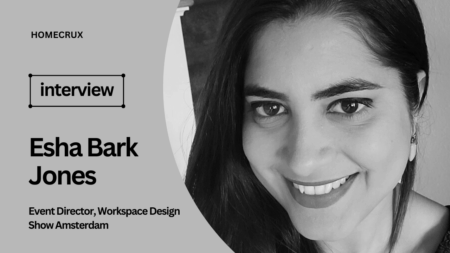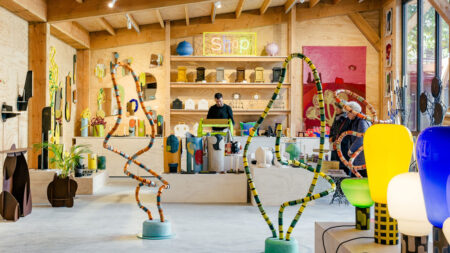For Joana Santos, design as a discipline is very recent. She never thought about becoming a designer, let alone running a design studio of her own. The Portuguese designer was initially more inclined toward music and painting but soon realized that no matter what she did design would be an essential part of her existence. It’s the thread that weaved her artistic and rational approach to life.
Hugo Silva on the other hand had a bent for design but was always very connected to sports. Growing up, he practiced canoeing for several years, even becoming a high−performance athlete. But soon he had to choose between continuing his pursuit of one day reaching the Olympic Games or continuing his education and learning the art of design, which had taken a backseat. Hugo chose the latter!
Today, both the designers live design in the same way they lived painting and canoeing, with the same ambition: to come first with a smile. Homecrux catches up with Joana Santos and Hugo Silva, the founders of DAM (DAM Portugal), a Portuguese brand specializing in creating sustainable furniture. The designer duo expresses their thoughts on the inception of the studio, the company’s present pursuits, and its future.
Homecrux (HC): Please tell us the inception story of Dam Portugal. When and how did Joana Santos and Hugo Silva meet? What did you do before starting your independent studio?
DAM Portugal (DP): DAM, the furniture and accessories brand, was born in September 2013 at 100% Design in London. It was there that we first presented the brand and the first pieces to the public. DAM stems from the entrepreneurial spirit of Hugo Silva and Joana Santos, who met at the University of Aveiro. In our professional journey, we engaged in quite distinct professional activities within different areas of design. Joana Santos worked in Graphic Design at various companies, developing branding and graphic communication projects. Hugo Silva worked as Interaction Designer for various companies within the field of museology and as a researcher and consultant for the University of Aveiro.
DAM was created from our initial desire to explore traditional materials and techniques that reflected a bit of us and the culture of our country. After winning the POPs 2013 competition, promoted by the Serralves Museum Store, which excited us, creating the DAM brand and its marketing structure was the next step.
HC: How do you guys keep your personal and professional life separate? What’s the relationship you share?
DP: In addition to our professional relationship over the past 10 years, we share a private life as a couple. The correct answer is: We can’t separate personal life from professional life. We have learned over time that the important thing is to respect boundaries in professional activities and respect each other’s space and time in private life.
Joana Santos is responsible for the commercial and branding areas, while Hugo Silva handles production and technical development. However, even understanding all this, creating a brand as a couple is not a recommended solution; it is necessary to build a support team in parallel to separate the activities. Behind the professional activities, it is important that each of us has our own individual routines, such as sports activities.
HC: How do you formulate a collective decision, considering there ought to be a difference in opinions?
DP: We both participate in the creative development of DAM’s products, where our creative skills are fundamental for business development. Decision-making always comes from building arguments capable of convincing the team. It is always a collective decision where everyone agrees. Consequently, it doesn’t always result in a quick process and requires extra effort in construction and argumentation. But on the other hand, it is a decision that commits and holds everyone accountable throughout its course. Thus, the results are always built collectively, believing that they protect each individual’s uniqueness.
HC: You are a multidisciplinary design firm with products ranging from lighting to furniture. How do you maintain a holistic approach to each subject and bring your expertise to the table?
DP: Balance! When designing the narrative of a product, we have to balance the mechanical and aesthetic characteristics of natural materials; the formal shape of the artifact; the development costs; its functional purpose; and our authorship − the dream. All of this while exploring different materials, colors, shapes, textures, and smells. These are products made in Portugal intended for interior design projects. They are pieces that make a difference in a space, creating a unique memory, whether it is a reception area, a social space, a workplace, or a place of rest.
We believe life is too short to waste time with disposable and boring products. We want people to fall in love with the spaces they visit and live in.



HC: What is the design philosophy at DAM Portugal studio?
DP: Blurring the boundaries between design, craftsmanship, and industry from a perspective of cultural and human value. To achieve this, we design pieces that tell stories, supported by a local identity strategy. As Designers, we are storytellers. We create synergies between artisans and industrial producers, combine different techniques and materials, and reference traditional Portuguese brands or objects. The challenge is to revisit a collective heritage that remains genuine and, therefore, distinctive. The goal is to promote Portuguese collective heritage in the international market, bridging the gap between Economy and Culture.
HC: DAM Portugal in itself is a very interesting name. What’s the inspiration behind the namesake?
DP: The acronym DAM stands for “Design Artesanato e Mobiliário” (which means “Design, Craftsmanship, and Furniture” in English). Nothing very creative, but simple and memorable. Furthermore, we can associate it with a surprise, like the expression DAMn.
HC: Do you believe that ‘Form Follows Function’ is not only limited to furniture but relevant to lighting and other disciplines as well? What’s the definition of design for you guys?
DP: Design is the project discipline that builds a narrative between the program, authorship, and technology. In this sense, the form follows the narrative, which is the story we want to tell people. The narrative of each product is primarily what distinguishes it from the rest. At DAM, products are born from stories we want to tell, like a book we take home and share and discuss with our family and friends. We want our pieces to be moments of reflection, discussion, and inspiration that are not indifferent and, in the end, bring a positive memory to each person.

HC: How do you perceive design festivals and events across the globe? What global design event/fair did you recently attend?
DP: We believe that the communication stage for brands is changing, or even at a point of indecision. After a near−total absence of international fairs and events during the COVID-19, the return seems more normal for brands with larger commercial structures. But the smaller brands, including ours, seek to be very objective in their choices. We question whether such a high investment is justified in the short and medium term in terms of economic return to sustain the company. We conclude that audiences are increasingly fragmented, and the vast majority of events no longer have the same commercial traction as in the past to sustain a smaller brand. Thus, the focus has increasingly been on private and focused events aimed at a specific market group through partnerships with other brands or distributors.
HC: AI is the biggest buzzword. What are your thoughts on the fact that AI will replace designers at some point?
DP: It is certainly already replacing many designers’ activities. It is a tool with superpowers, much like graphic software was in the past for paginating a book or modeling a form. AI is bringing the same revolution, and today, these are perfectly ordinary tools, accessible to everyone, and an integral part of our training. Now we must choose: adapt or fall behind.
HC: What are the future projects that you are working on? Could you share your studio’s ambitions for the next ten years?
DP: Our focus is to be the preferred sustainable product brand for decoration professionals in Europe. To this end, we aim to have a high export rate, promote “made in Portugal,” retain customers, and attract new ones. We also intend to form new partnerships with other designers and design studios, thus opening up space for new experiences, recognizing and promoting the magnificent work of some national designers, and presenting their work to the world.


HC: Take us through a daily routine in a designer’s life. How do you go about selling your products and collaborating with big-scale manufacturers? Are you selling in Portugal only or are you exporting to other countries as well?
DP: At DAM, we sell products to professionals from architecture and design studios who develop residential, corporate, and hotel interior projects, as well as to stores and distributors who sell high-value design products. These professionals are mostly in the international market, like the UK, Germany, and France. When we sell products in Portugal, the orders always have a connection to the international market, such as an international studio with an office in Portugal or a professional from a foreign country who decided to live and work in Portugal.
The national market represents a small part. However, it comes with good surprises, like the Craveiral Farmhouse, a rural tourism destination that prioritizes nature conservation on the Alentejo coast in São Teotónio. DAM produced catalog pieces and developed customized products, equipping 33 rooms of this rural accommodation with bedside tables, coat racks, chairs, and tables, among others.
We produce everything in Portugal. Our country has various specialties in production, large know-how, and factories of different sizes. This also allows us to develop products of high quality, use excellent materials, and employ artisanal production techniques that enable the development of original products that evoke distinctive experiences and sensations. The details achieved through this combination also make the products difficult to imitate. Developing customized solutions, producing small or large series, and providing dedicated personal customer service are also key factors.
HC: Could you name your favorite project and favorite designer? Any design magazine that you like to read?
DP: We always have to talk about the designers who inspired us to be designers, and in our case, we also had the privilege of being trained by them at the University of Aveiro in Portugal. They are, for example, Francisco Providência and Carlos Aguiar. Both are part of the history of design in Portugal, recognized and awarded multiple times in the national and international markets.
They are an inspiration for many Portuguese designers due to their positioning and attitude in how they do and think about design. Due to their poetry and simplicity in designing a solution and a narrative. There is a magazine in Portugal that we have followed since its first issue, “Observador Lifestyle,” which was created from an independent and entirely digital journalistic project. This printed magazine is a 100% Portuguese publication of articles about photography, illustration, and design, mainly with origin in Portugal.
We thank Joana Santos and Hugo Silva for taking out time for this insightful conversation!
Follow Homecrux on Google News!




